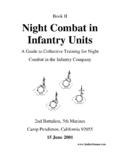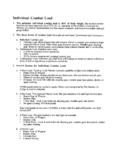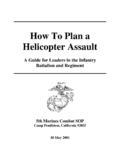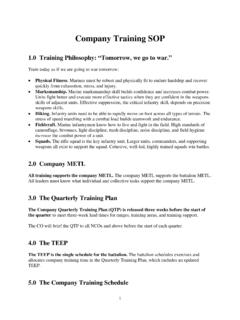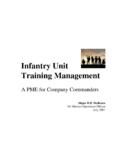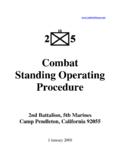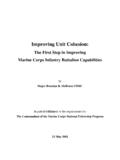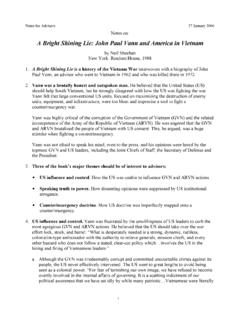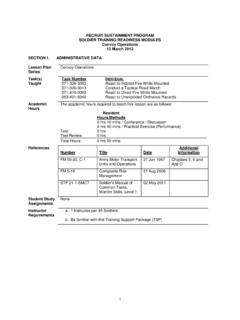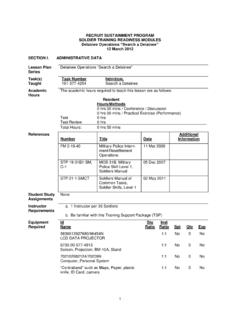Transcription of PISC Barracks Need to Provide 72 sq ft per Recruit
1 22 Jun 07 PISC Barracks Need to Provide 72 sq ft per Recruit Parris Island Violates MCO by Overcrowding recruits Ref: (a) MCO Marine Corps Housing Management Manual[1] (b) DepO Recruit Training Order (RTO) (c) Impact Study of Overcrowding Barracks in a Recruit Training Environment, Blaesing, Parris Island, 1 April 2007 1. Parris Island violates Marine Corps Order by overcrowding recruits . a. MCO , ref(a), para , mandates 72 sq ft per Recruit . The RTO, ref (b), para , mandates 72 sq ft per Recruit . b. 1st RTBn and 2nd RTBn Barracks squadbays measure 5252 sq ft. These squadbays should house a maximum of 72 recruits each. See Figure 1. c. 1st RTBn squadbays were overloaded 21 of the last 42 cycles, from 2004 through June 2007: 50% of the time.
2 No waivers were granted. d. Overcrowded platoons exceed the number of shower heads and toilets in the Barracks , the number of tables in the chowhall, and the number of seats in the classrooms. Overcrowded platoons exceed the throughput capabilities of both our garrison and field training facilities. Figure 1. Standard Squadbay Size: Building 591, 1st Deck, Lead Side Squadbay Area = 5252 sq ft X = 5264 minus 12 sq ft of stanchions = 5252 Max recruits per Squadbay = 72 recruits 5252 72 sq ft = 72 recruits 2. The RTO, ref (b), is in violation of Marine Corps Order. RTO para specifies 88 recruits for 1st and 2nd RTBn, waiverable to 92. a. The RTO numbers are inflated. Heads, laundry, hallways, offices, and closets are incorrectly added to calculate the overly-large RTO figures.
3 NAVFAC P-80[2] is clear, one equal share of open bay sleeping space. This is exclusive of stairs, halls, heads, and utility rooms. Other DoD standards concur.[3][4][5][6][7] b. The RTO incorrectly establishes the Depot G-4 as the authorizing agent for waivers. Ref (a), para , requires medical waivers in emergency situations. Ref (a) does not authorize blanket waivers. 1 22 Jun 07 3. The Master Projection Plan is in violation of Marine Corps Order. The MPP violates MCO , para , by pre-planning for a continuous waiver of the minimum space standards. 4. Overcrowded squadbays greatly increase the spread of infectious disease. See ref (c), Impact Study of Overcrowding Barracks in a Recruit Training Environment.
4 Result 4 shows that a Recruit has a 31% higher chance of contracting disease in a large platoon exceeding 70 men. a. Excess disease generates sick days, light duty days, drops, and recycles. Excess disease significantly taxes our training processes and facilities. 31% more disease requires 31% more medical personnel, more treatment time, more facilities, more costs, and more secondary hospitalizations. 31% more disease generates 31% more lost training-days, more re-training time, more transportation and supervision, more paperwork processing, and more lost instructor-days. As this effort is tied to overcrowding, reducing overcrowding would save tremendous personnel, facility, and resource costs and time. b. The costs to improve Barracks capacity need to be balanced against the medical and training costs currently lost.
5 PISC is inflicting excess casualties on an already-stretched Navy Medical system. c. There is a point of diminishing returns where the increasing rate of new recruits does not generate a similar increased graduation rate. d. 1996 CDC guidelines recommend 36 inches between infectious and susceptible patients. Barracks 589, 591, 599, and 601, each with a length of feet, should contain eighteen 36-inch double racks a side: 72 recruits per squad bay. Other studies concur.[8][9][10] 5. Overcrowded squadbays decrease indoor air quality. Indoor air quality, especially the excessive carbon dioxide buildup common in poorly ventilated Barracks , affects Recruit physical performance, cognitive retention, mental health, regeneration, and rest. Excessive CO2 is associated with malaise, fatigue, headaches, and inattention.
6 A. PISC Barracks should be tested for acceptable CO2 levels and hourly rates of fresh air exchange. These rates are especially critical during the overnight resting hours. b. Our overcrowded Barracks first increase disease, and then decrease Recruit rest, recovery, and performance. Competitive athletes would not sleep in our Barracks . 6. Recommendations. 1st and 2nd RTBn Barracks should be capped at 72 recruits per squadbay. The RTO should be updated to comply with MCO. Barracks HVAC systems should be upgraded to meet current indoor air quality standards. Prepared by: LtCol McBreen, 1st RTBn, MCRD PISC 843-228-2467 2 22 Jun 07 Notes: DoD References on Barracks Space Standards [1] MCO Marine Corps Housing Management Manual, 14 February 1991.
7 [2] UFC 2-000-05N (Formerly NAVFAC P-80) Facility Planning Criteria for Navy and Marine Corps Shore Installations. 31 January 2005. Section 721-15 Recruit Barracks . September 1993. [3] UFC 4-721-10 Unified Facilities Criteria (UFC): Navy and Marine Corps Bachelor Housing, Chapter 9, page 9-1. 31 July 2002. [4] NAVMED P-117 Manual of the Medical Department. Chapter 22: Preventive Medicine and Occupational Health. Change 126, 12 August 2005. [5] OPNAVINST Policies and Procedures Governing Bachelor Housing. 20 March 1997. Cancelled in 2006. Superseded in 2007 by CNIC Housing Management Manual. NAVPERS 15606 Navy Bachelor Quarters Manual was cancelled in 1997 and superseded by OPNAVINST [6] NAVMED P-5010 Manual of Naval Preventive Medicine. Chapter 2, page 2-3.
8 1995. [7] FM 8-250 Preventive Medicine Specialist, Section 19-2. References on Barracks Space and Disease Rates [8] Building-Associated Risk of Febrile Acute Respiratory Diseases in Army Trainees. Brundage, et al. JAMA, April 8, 1988, Vol 259, No. 14. [9] Selected Nonvaccine Interventions to Prevent Infectious Acute Respiratory Disease. Lee, et al. American Journal of Preventive Medicine, 2005;28(3). [10] United States Army Guidelines for Troop Living Space: A Historical Review. Brodkey and Gaydos. Military Medicine, June, 1980. 3
